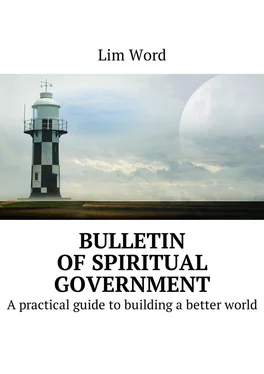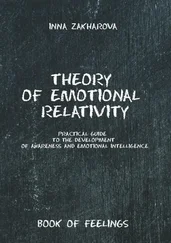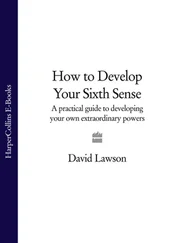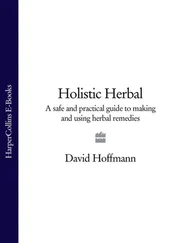Lim Word - Bulletin of Spiritual Government. A practical guide to building a better world
Здесь есть возможность читать онлайн «Lim Word - Bulletin of Spiritual Government. A practical guide to building a better world» — ознакомительный отрывок электронной книги совершенно бесплатно, а после прочтения отрывка купить полную версию. В некоторых случаях можно слушать аудио, скачать через торрент в формате fb2 и присутствует краткое содержание. ISBN: , Жанр: Публицистика, Религиозная литература, Эзотерика, на английском языке. Описание произведения, (предисловие) а так же отзывы посетителей доступны на портале библиотеки ЛибКат.
- Название:Bulletin of Spiritual Government. A practical guide to building a better world
- Автор:
- Жанр:
- Год:неизвестен
- ISBN:9785448593963
- Рейтинг книги:5 / 5. Голосов: 1
-
Избранное:Добавить в избранное
- Отзывы:
-
Ваша оценка:
- 100
- 1
- 2
- 3
- 4
- 5
Bulletin of Spiritual Government. A practical guide to building a better world: краткое содержание, описание и аннотация
Предлагаем к чтению аннотацию, описание, краткое содержание или предисловие (зависит от того, что написал сам автор книги «Bulletin of Spiritual Government. A practical guide to building a better world»). Если вы не нашли необходимую информацию о книге — напишите в комментариях, мы постараемся отыскать её.
Bulletin of Spiritual Government. A practical guide to building a better world — читать онлайн ознакомительный отрывок
Ниже представлен текст книги, разбитый по страницам. Система сохранения места последней прочитанной страницы, позволяет с удобством читать онлайн бесплатно книгу «Bulletin of Spiritual Government. A practical guide to building a better world», без необходимости каждый раз заново искать на чём Вы остановились. Поставьте закладку, и сможете в любой момент перейти на страницу, на которой закончили чтение.
Интервал:
Закладка:
Belltowers. Are located at the entrance to the temple, on either side of the entrance, or above it (in the singular), are usually merged with the building. Their main purpose is a signal to the church service. In the Western tradition, often used carillon – a mechanical tool that performs on the bells any melody.
The chapel (chapel). Dedicated part of the temple, to accommodate an additional altar with a throne. Thanks to the chapel, in one temple it is possible to perform more than one liturgy (from Greek λειτουργία “common cause”) per day. This rule is the same for the Catholic and Orthodox churches. It can be said that after the main worship, this altar must accumulate a special force for at least 24 hours.
Saddledness. The intersection of the main nave and the transept (transverse nave). Usually it is crowned by a dome or a tower.
Transsept (from Latin “for” and “fence”). The transverse nave, outside the main building, forms dome-shaped protuberances.
Apse. In Western European architecture, a semicircular ledge, or a similar in form internal part of the temple, which contains an altar complex.
Crown of chapels. A series of chapels separated from the choir by a de-ambulant.
Chorus (from other Greek хορός, group dance). The space before the main throne, where the chorus of singers is placed. Now it includes the Presbytery (Latin Presbyterium – a place for the elect), where only priests could previously go. In some Catholic churches, and now the place of the choir is fenced off by a balustrade – or is provided for a free tour to all visitors. There may also be a wind organ, a priest-musician, a pulpit, a table and chairs for the preacher.
Deambulary (from the Latin ambio – walking around all around). A semicircular bypass gallery that allows parishioners to pass through the presbytery to the chapels, small altars or sacred relics, and (through the patterned lattice) to survey the shrines that are in the main altar part.
2. Orthodox church.
1) Throne (altar, from the Latin altarium, “high”, pommel of the altar). The name is common in the Orthodox tradition. In Ancient Greece, the altar (a powerful stone foundation) is essentially the temple itself. The Throne of the Eastern Church is approximately equal to the altar of the Western Church.
The Orthodox throne is a square table, the seat of God’s presence. Here are the sacred relics. (1) – antimins, scarf, with the sign of the cross, with stitched parts of the relics, as well as the signature of the bishop of the diocese, to which the temple belongs. Antimins is a document authorizing the celebration of the Liturgy. When the service is performed, the antimension unfolds, a chalice and a discus are placed on it – vessels for wine and bread, necessary for communion. Only the priests in full service clothing can touch the scarf, or (at the time of out-of-worship service) with a ribbon trimmed (Greek επιτραχήλιον – that around the neck). In certain cases, due to its strength, the antimension can replace the throne itself.
(2) The Gospel (New Testament).
(3) One, or more often two, of the altar cross. Crosses are used for the celebration of the Liturgy, for the blessing of the prayers, for the blessing of the water for the Epiphany, and especially for solemn prayers.
(4) The tabernacle (kiwot). The sacred vessel, the casket, where the holy Gifts are stored – the Body and Blood of Christ, used for communion (Eucharist, from other Greek εὐ-χᾰριστία – thanksgiving, honor, gratitude). The body is round, somewhat bifurcated, as a sign of the divine and human nature of Jesus Christ, reminiscent of the seal of a piece of bread, a prosphora (προσφορά – “offering”), is made from wheat flour, with yeast, water and salt. Wine – in Orthodoxy usually red, sweet (Cahors). In the Latin rite, liturgical bread is called unleavened bread, a guest (Latin hostia – “sacrifice”), or a robe (Latin oblatio – offering, offering, gift), it is baked exclusively from flour mixed with water, and resembles a thin coin. Wine, as a rule – white.
A consecrated, functioning temple, ideally – a place where the sky descends to the earth. You can add that the difference between the temporary and the transcendent, the eternal, disappears, one can feel the infinity of taste, so that he begins to like it.
The sacraments of the Eucharist consist of a) proskomedia (Greek “offering”), when the priest, after reading the prayers for the sending of the Holy Spirit, in the presence of many believers, but also with the closed Royal Gates, prepares the Blood and the Body on the Throne. Wine is mixed with water and poured into the chalice. Prosfora is cut with a special copy – a ritual double-edged knife with a triangular blade. c) Liturgy of catechumens (taught in the faith, as well as penitent and excommunicated). In the Great Litany (Greek “extended prayer”), global (then first) global, then smaller, general church and social, then personal petitions are raised. a) Liturgies of the faithful (there are only persons who have accepted baptism). The prepared Holy Gifts are solemnly transferred from the altar to the throne through the North Gate: before the iconostasis, believers. After that, the Royal Gate closes, the altar curtain is pulled up. The remaining priests read the eucharistic prayer anaphora, after which the Woof (lifting upward) of the Holy Gifts takes place. At this moment, mysteriously, wine and bread are converted into the Blood and Body of Christ.
The priests take communion, then they receive the Holy Mysteries of Christ and the laity.
In the Roman rite the Eucharistic Liturgy is called the Mass (perhaps from the Roman missio – mission, message). There are no fundamental differences. The service is conducted in Latin.
2) The altar. A quadrangular table, hidden in the same “clothes” as the throne, to the left of the high place (the northern part of the temple). The location of the sacred vessels, as well as bread and wine – gifts of Christians, suitable for the celebration of the Eucharist. In between the services, he closes the veil.
The upper part is a part of the Orthodox church opposite the throne, near the central part of the eastern wall. In a small niche, on a certain elevation there is a pulpit (throne, a high altar) for the bishop. The throne is surrounded by a semi-circle of seats (synthron) of priests of lesser rank. In some parish churches, the place is designated more only by an icon lamp, or by a tall candlestick with candles.
3) Altar. The space between the semicircular (eastern) wall is an apse and the iconostasis.
4) Ponomar (northern), it is sometimes “paradise”, because of the usual themes of the painting, the door in the iconostasis.
5) Sacristy (a storage room, a deacon). Place in the altar, several cabinets, or a separate room for storing the liturgical garb of priests and church utensils.
In the sacristy lead the southern, otherwise, the deacon’s doors of the iconostasis.
The spiritual person in charge of the sacristy is a sacristan. In Catholic churches, the sacristy is also called sacristy (Latin sacrum – sacred utensils). Mass begins with the solemn release of the clergy from sacristy. Here you can privately talk with a clergyman.
Ponomar – other Greek. παραμοναριος – “gatekeeper”, he is an altar boy, sexton, a servant of the Orthodox Church, obliged to ring bells, sing in the choir (elevations on the sides of the salt), monitor the order, serve during worship.
Deacon – from other Greek. διάκονος – minister of the first, inferior priesthood degree. Below him in the church hierarchy is only the clerk, the subdeacon is a cleric (he is a true believer, but not ordained as a parishioner). The deacon does not have the right to perform the sacraments himself. Appeal to the deacon on solemn occasions: “Your gospel”, “Your loud voice”, or “Your God-love”.
Читать дальшеИнтервал:
Закладка:
Похожие книги на «Bulletin of Spiritual Government. A practical guide to building a better world»
Представляем Вашему вниманию похожие книги на «Bulletin of Spiritual Government. A practical guide to building a better world» списком для выбора. Мы отобрали схожую по названию и смыслу литературу в надежде предоставить читателям больше вариантов отыскать новые, интересные, ещё непрочитанные произведения.
Обсуждение, отзывы о книге «Bulletin of Spiritual Government. A practical guide to building a better world» и просто собственные мнения читателей. Оставьте ваши комментарии, напишите, что Вы думаете о произведении, его смысле или главных героях. Укажите что конкретно понравилось, а что нет, и почему Вы так считаете.












